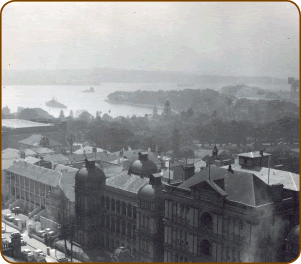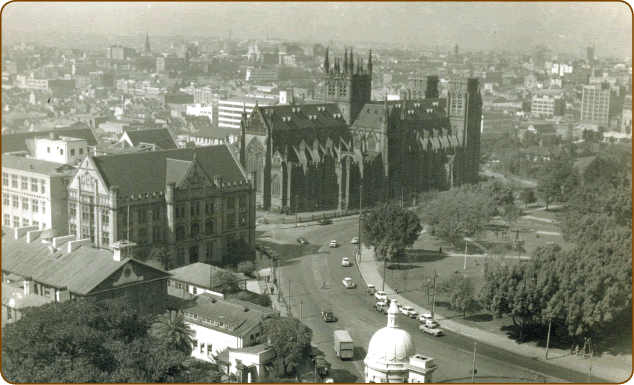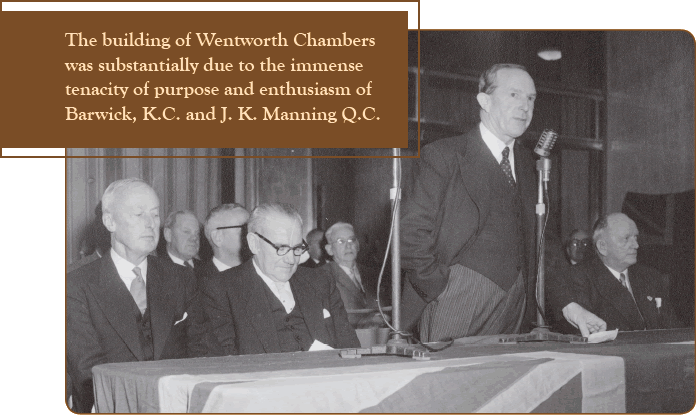

View of Sydney Harbour from roof of Wentworth Chambers 1957. |
In April 1948 at a special meeting Council discussed the possibility of building, purchasing or leasing suitable premises for chambers. It was decided that purchase or lease would be preferable to undertaking the construction of a new building and a sub-committee was appointed to make enquiries, but these were disappointing and it was not until 1950 that a substantial proposition emerged. This was the sale of Trenton House in Phillip Street which the committee inspected and considered worthy of an architect's report. After analysis the scheme to acquire that building was abandoned as economically impracticable. A suggestion was also pursued that the Supreme Court and the Bar might be housed together in College Street but nothing came of this. Because of these tribulations the idea grew in favour that the construction of new premises might be less difficult after all. |

View of St Mary's Cathedral from roof of Wentworth Chambers 1957. | |
|
By May 1951 Barwick, K.C., then President of the Bar Association, was able to report having commenced negotiations with the State Attorney-General to acquire vacant land in Phillip Street between Denman and Selborne Chambers. Part of this had been transferred to the Public Trustee before the depression and was intended for his department's offices but, after the war, these were moved to O'Connell Street and thereafter the old site was used as a car park. The other part was the home of the late Dr. Fiaschi which had been resumed on his death by the Crown to accommodate part of the Crown Solicitor's staff. The whole area was not at that time required by any government department. A building company was invited to prepare a rough plan and estimates for a building providing an arcade of ten shops at ground level, a first floor reserved for the Crown, twelve floors each consisting of twenty-two barristers' chambers, a meeting hall capable of use as two courts, and a basement restaurant. This was done by Paynter and Dixon Pty. Limited without charge to the Association. A circular was sent to all members of the Bar telling them of the proposed building and suggesting that rooms should become available between £750 and £1000 each. Negotiations proceeded between Barwick, K.C., and J. K. Manning, then Hon. Treasurer of the Bar Association, on the one hand with the Attorney-General, the Crown Solicitor, the Minister for Justice, the Minister for Building Materials and the Chairman of the Public Service Board on the other. It was agreed in principle that the Minister for Public Works would lease the whole of the land to a company to be formed by members of the Bar Association and that the lease should be authorised by Act of Parliament. A Bill was drawn and submitted to Cabinet and after Barwick had enlisted the co-operation of the Premier and the then Attorney-General, C. E. Martin, it was approved and enacted as the Phillip Street, Sydney, Land Lease Act, 1952. The Act empowered the Minister to lease the land to the company, or nominees of the Bar Association as trustees for the company, for ninety-nine years commencing not later than 1 January 1954, on condition that the company erect a building expeditiously to provide accommodation for barristers, courts and offices for Crown use. At least nine floors in the building were to be available for the Bar and the Bar Association; one floor was to be |
for the Attorney-General at his option for office accommodation for his department or that of the Minister of Justice and another floor was to be used for two courts. This consummation was substantially due to the immense tenacity of purpose and enthusiasm of Barwick and Manning who remained undaunted by an acute shortage of building materials, as well as of funds to credit of the Bar Council – then hardly sufficient to pay initial consultants' fees. Manning in a circular to the Bar shortly before the Bill became law accurately remarked: "A great deal of work has been entailed in the preparation of the scheme and an enormous amount must still be done." In the vanguard of the new problems was the raising of an estimated £600,000 to finance the project. The Mutual Life and Citizens' Assurance Co. Limited was approached and agreed to advance £450,000 or 75 per cent of the estimated cost. This left a modest £150,000 to be found. If 150 members of the Bar would take shares of £1,500 paid up to £1,000 each the balance could quickly be met but it was realised that a lot of men would want to take up shares on a deposit and instalment basis. Barwick and Manning next called on Mr. Alec Osborne. Then General Manager of the Commercial Banking Company of Sydney Limited. In effect they turned out empty pockets to him saying – “The M.L.C. will back us for £450,000. If 150 members each take a £1,500 share they will become liable to pay £225,000. We shall call up £150,000 and leave £75,000 of uncalled capital.” The bank agreed to lend the needed £150,000 and the financial problem was thus solved. To implement the scheme Counsel's Chambers Limited was incorporated on 24 October 1952. By its Articles the number of Directors was to be not less than three nor more than seven. The first appointees were Barwick, Hugh Maguire, Manning, P. B. Toose and J. R. Kerr. The resignation of Maguire was accepted in 1953 after his elevation to the Bench. In February 1954 R. F. Cross and J. E. H. Pilcher were appointed additional Directors. Applications for shares were invited and in this the whole scheme met a most challenging test. It was hoped to close the list by 15 March 1954 but insufficient applications were received. |

Lord Morton and Premier Cahill listen on as Sir Garfield Barwick Q.C. delivers his speech at the opening
ceremony of Wentworth Chambers on 20 August 1957. To the right is the Hon WF Sheehan (Attorney-General). | |
| Previous Page | Next Page | |